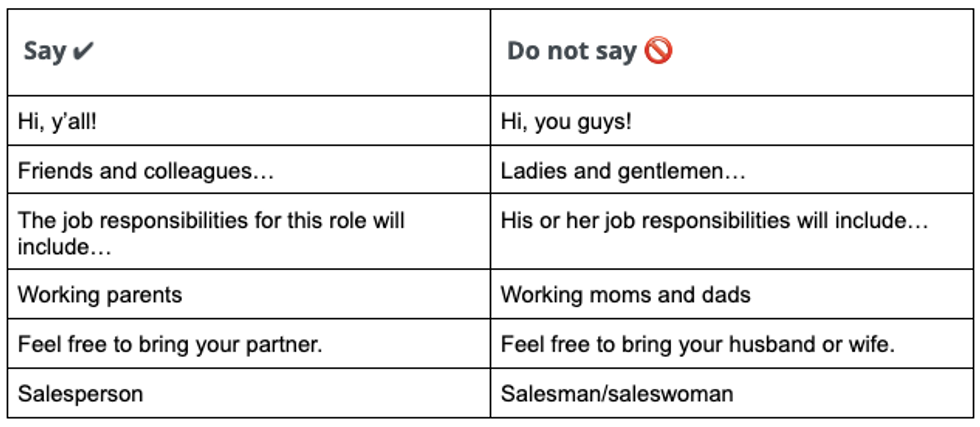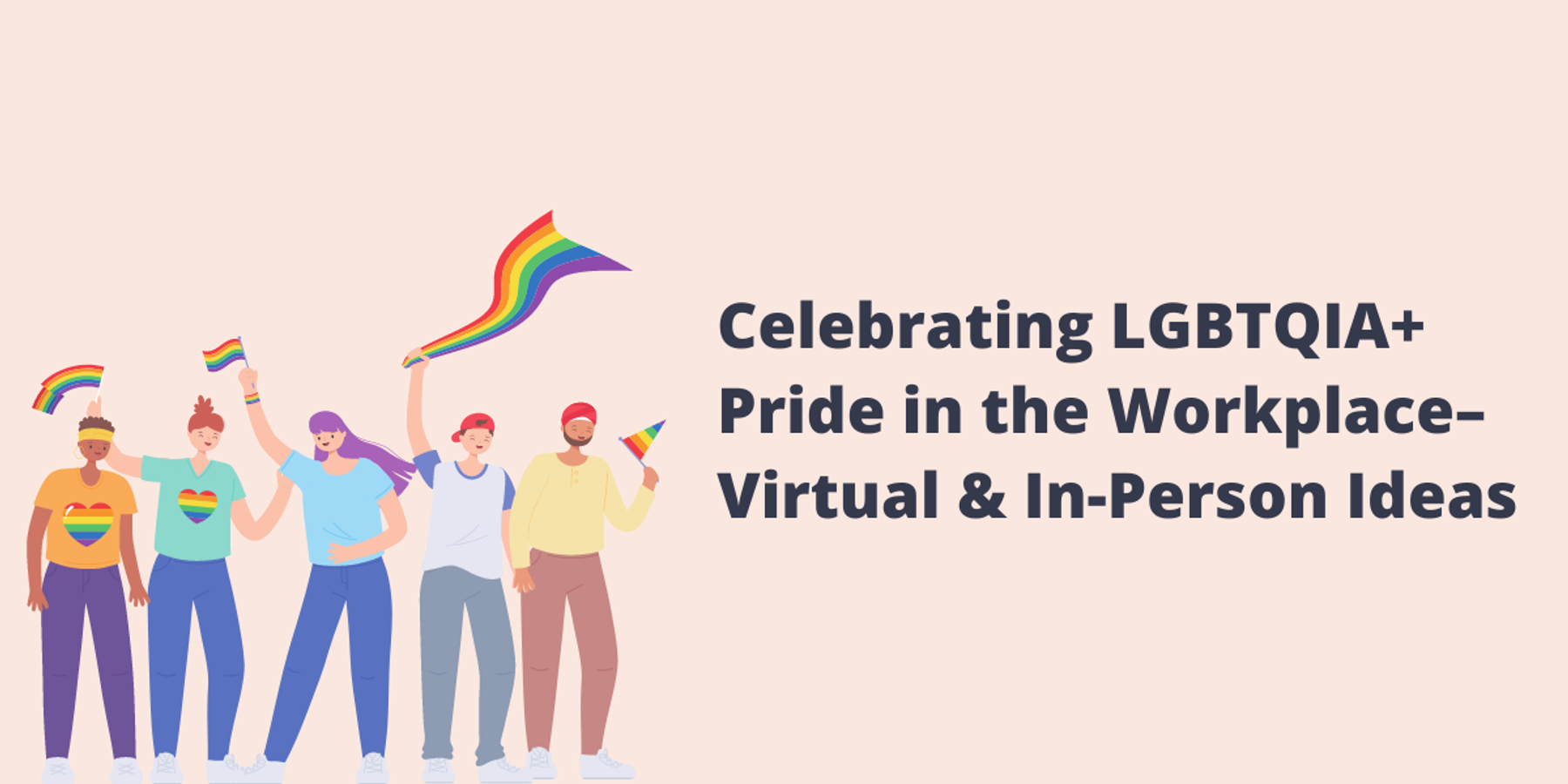Diversity, equity, inclusion, and belonging (DEIB) work is sometimes in the details. A study by PowerToFly showed that although a majority (72%) of participating organizations have LGBTQIA+-focused employee resource groups, only 50% encourage gender pronoun identification. A mere 18% have held trainings to address gender pronouns at work.
As a company leader, you may feel confused over the best way to be sensitive. You are willing to meet the needs of your team members in an ever-evolving space, but you may simply not know how. Facilitating pronoun sharing at your organization will go a long way in creating an open and welcoming environment. Below, we’ll walk through seven practical steps your company can take to practice more inclusive workplace communication.
Why do we talk about pronouns at work?
Why are gender pronouns at work important? Let’s start by acknowledging that pronouns and identity are important concepts to people’s lives in general. Outside a work setting, how people present themselves affects daily life. Every interaction is socially informed by how we are perceived by others. Being perceived as their correct gender (or as gender non-binary) makes a person feel seen. The same is true at work.
As decision-makers, we also know this hard truth about retaining talent: Happy employees stay, while unhappy people leave. Per a Catalyst report and McKinsey findings, 1 in 10 LGBTQIA+ employees reported leaving a job because of an unsupportive work environment. In fact, 50% of all LGBTQIA+ employees in the U.S. are closeted in the workplace because they are unsure or fearful that it wouldn’t be a supportive environment. Whether we’re talking about gender identity or sexuality, being seen affects our work.
Also, we talk about gender pronouns at work because it’s our job to. Our work is to foster environments where our employees feel they can be themselves. Need stats to back it up? See the complete guide Inclusive Language: How to Talk about Gender & Sexuality at Work from PowerToFly. With the increasing use of non-binary or gender-nonspecific pronouns, making our employees feel welcome means leading education efforts and ensuring open communication around pronouns at work.
Face the reality
Normalizing the use of gender pronouns at work is key to creating a sense of belonging for everyone on the team. According to Pew, 42% of American adults know someone who is transgender. Half that number knows somebody who uses a gender-neutral pronoun like they/them. Since gender is a spectrum, the pronouns we use need to reflect that. Many people choose to use gender-neutral pronouns, multiple pronouns, non-traditional pronouns, or even no pronoun at all! Our pronoun choices reflect personal identity and should be respected at all times.
Safety is an absolute factor in the workplace. Since 2019, U.S. state legislatures have introduced a record number of anti-trans bills (more than 100 in 2021 alone) that discriminate and criminalize people based on gender identity. With 2021 being the deadliest year on record for transgender and gender non-confirming people, violence against trans people is on the rise. A concrete way for trans and gender non-conforming employees to feel safe (whether out or closeted) at work is to have their identities seen and respected in the workplace.
Know your team members
Some might ask “How do you avoid pronouns at work?” but this is not a solution. According to Harvard Business Review, the best approach to a respectful conversation about gender identity and pronouns at work is to stay clear, straightforward, and casual (and, of course, to not put folks in situations where they feel forced to disclose personal information).
It’s also best to, when addressing people, use non-binary terms from the outset, so as not to exclude trans or non-binary team members by constantly being gender-specific. Don’t assume people’s pronouns based on their appearances, and stick to gender neutral language in group settings, too.
Sharing pronouns at work: 7 practical steps
How do you respectfully use gender pronouns in the workplace? A good place to begin as a leader is to start the conversation. Attitudes towards pronouns at work can be set by decision-makers like you.
1. Always share your pronouns first
How do you use pronouns at work? Create an open environment by sharing yours first. Remember to bring up pronouns when you introduce yourself one-on-one.
- “I’m Trisha. I go by she/her pronouns. Nice to have you on the team.”
2. Model, don't mandate
In a group, set the tone for introductions by leading with your pronouns, too. Cisgender people, or those who identify with their gender assigned at birth, may learn a thing or two about identity in the process. Note that it’s best to model this behavior without explicitly requiring it; you, again, don’t want to put anyone in the position of feeling forced to share.
- “Let’s go around and make introductions. I’m Trisha, my pronouns are she/her, and I’m the CEO.” Versus: “Let’s go around and share our names, titles and pronouns.”
3. Include gender pronouns in your work email signature
Include your pronouns in all your work signatures, out-of-office, and away messages. Not sure how to structure it? A simple example is below. For a more uniform solution to use company-wide, you might consider reaching out to a DEIB-focused mentorship program for guidance.
- “Caroline Mayo (she/her/ella)”
4. Don’t overcorrect
Addressing gender pronouns at work doesn’t need to be uncomfortable. If you forget or aren't sure of a person’s pronouns, just use that person’s name. If you make a mistake when referring to them, stay calm. A quick apology and correction is fine before moving on.
- “My mistake. When he is back after the break, Aiden will lead the team meeting.”
5. Don't police without permission
What about when you hear someone else refer to a teammate by the wrong pronouns at work — what’s the best way to respond here? Know that there really isn’t a single, blanket solution, since not every person who’s been incorrectly gendered will want the same type of response or intervention. People are individuals, and it’s important not to lump all employees together who, for instance, use they/them pronouns by assuming they’ll want the same thing. Whenever possible, it’s best to hear directly from individuals themselves about how they’d like to be supported in these situations and at work in general.
That said, if you hear an incorrect pronoun used, the following example may be sufficient for the situation:
Colleague: “I was thinking we could ask Sara to take on this project. She’s great at this sort of thing!”
You: “I think that they would be a great fit for this project, yes.”
Colleague: “Sorry, yes! They would be perfect.”
How about if you repeatedly hear someone refer to your colleague by their wrong pronouns, knowing that they've been made aware of what their correct pronouns are — what then? Don't go straight to HR without talking to your colleague who is being misgendered first. That's a classic example of how supposed "allyship" becomes harmful. You should be listening to what your colleague wants to do about a situation like this that impacts them, not making assumptions.
6. Audit the wording of your hiring processes
One of the most basic places to address pronouns at work is with your hiring process. How is your HR system presenting a gender pronouns list to potential applicants? Are you scaring away trans and gender non-binary individuals by including or excluding certain options? There are three ways to go here:
- Add more options: The Human Rights Campaign Foundation suggests the addition of the more inclusive “Mx.” if you already have “Ms.” and “Mr.” as options.
- Offer a text box: Give candidates the option to self-identify.
- Leave gender off: Consider eliminating gender from applications until further along in the process.
Remember that for some, their legal name isn’t the name they go by professionally or socially. Include a space for names that aren’t reflected by official identification documents. During the interviewing process, suggest that recruiters and hiring managers share their pronouns as well as ask candidates how they’d like to be addressed. Then, reflect that response throughout the process. If a candidate knows early on that the company is supportive of all pronouns, there is a strong foundation.
7. Make a plan for facilitating pronoun updates
Haven't yet managed someone who's updating their pronouns? Don't wait until you encounter this situation for the first time to know what your plan of action will be! Know in advance what logistical steps you can offer to take to support someone in this position, especially if a pronoun change is accompanying a larger gender identity update.
Common pronouns on job applications
Here’s a short gender pronouns list with commonly used terms today.
- He/him - traditional male pronouns
- She/her - traditional female pronouns
- They/them - gender-neutral pronouns
- Ze/hir - gender-neutral pronouns borrowed from non-English languages
Keep in mind that pronouns continue to change and evolve over time. The list can grow. Some individuals are comfortable with multiple pronouns too; for example, “she/they.” Note, too, that international workplaces with multilingual team members should consider seeking out further guidance, as from a global DEIB consultancy team like PowerToFly.
Continue to learn about emerging practices
As social theories evolve, so do the variations of gendered and non-gendered pronouns that we collectively use. By continuing to learn, keeping the conversation open, and incorporating emerging practices, employees at every level of your organization can enjoy an inclusive, safe, and identity-affirming work environment.





